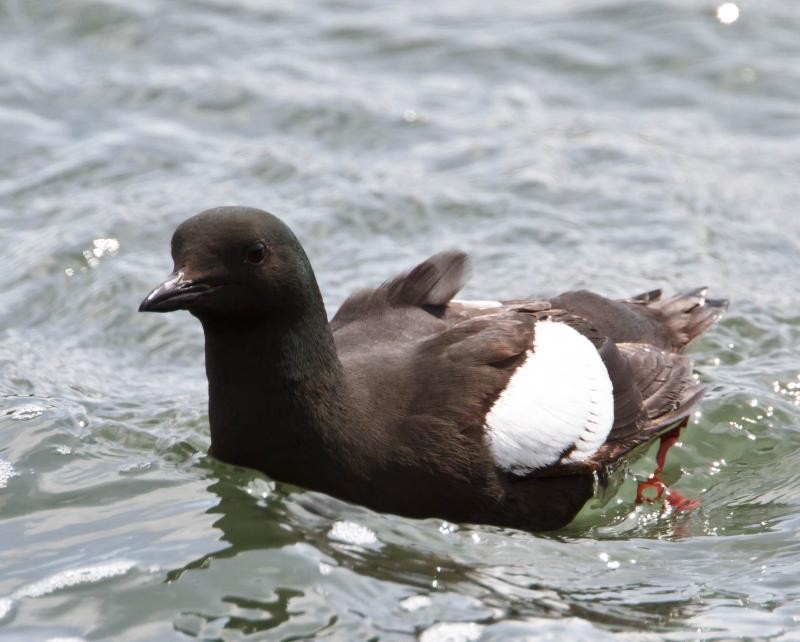Black Guillemot
A species of Guillemots Scientific name : Cepphus grylle Genus : Guillemots
Black Guillemot, A species of Guillemots
Botanical name: Cepphus grylle
Genus: Guillemots
Content
Description People often ask General Info
Description
The Black guillemot is a medium-sized bird with adults normally 30 to 32 centimetres (12 to 12 ⁄2 inches) in length and with wingspans of 52 to 58 cm (20 ⁄2 to 23 in). The bodyweight can range from 300 to 460 grams (10 ⁄2 to 16 ounces). Adults have both summer and winter plumage and there is no sexual difference in this that can be identified in the field. The English common name “Black Guillemot” references their strikingly black breeding summer plumage which is totally black except for a large white patch on the upper side of their wings. During the summer plumage, their legs, feet and inside of the mouth are all a bright coral-red, and their beak is a black. Adults lose their summer plumage in an early fall moult where their upper plumage become barred with light grey and white, their head is a pale grey, their underparts white, and legs and feet a pale red. They retain their white wing patch, black beak and red inside their mouth. The call in the breeding season is a high whistle. The red gape is also prominent then. Juveniles and immatures can easily be identified by the spotting of the white wing patch with grey or brown feathers and is easy to see even at far distances in the field. 
Size
31 cm (12.14 in)
Colors
Black
Gray
White
Life Expectancy
26 years
Nest Placement
Cliff
Clutch Size
1 - 2 eggs
Feeding Habits
Black Guillemot primarily consumes small fish, supplemented by invertebrates like crabs, worms, and mollusks. Black Guillemot dives to catch prey, using wings for propulsion and feet for steering. Prey is seized with a bill jab, swallowed underwater if small, or processed on the surface if large. Diet varies seasonally and regionally.
Habitat
Black Guillemot occupies cold, marine habitats, predominantly along rocky shores and islands of the northern Atlantic and Arctic regions, from boreal to high arctic waters. This bird species nests in coastal crevices and under boulders, mainly foraging in inshore waters up to 100 feet deep during breeding times and occasionally further afield or near pack ice in winter.
Nest Behavior
Black Guillemot's nesting behavior is characterized by a lack of elaborate nest-building, with pairs sometimes laying eggs directly on the ground. Parents exhibit dedicated care, ensuring the safety and warmth of the eggs and fledglings in the chosen nest sites.
Nest Characteristics
Black Guillemot often nests above the high tide mark on rocky coasts within cliff crevices, gaps between boulders, holes under tree roots, old puffin burrows, or beneath jetsam. Some pairs forgo constructing nests, while others create simple structures using pebbles, seaweed, feathers, bones, and shells; sizes of these nests and cavities can vary widely.
Dite type
Piscivorous
People often ask
General Info
Feeding Habits
Bird food type
Behavior
Black Guillemot typically maintain lifelong monogamous relationships, returning annually to prior nesting grounds to engage in unique courtship rituals that include aquatic displays, vocalizations, and striking foot-raising marches. Their parental duties are shared equally, punctuated by intricate greeting ceremonies during shifts. While they may nest in solitude, in the Arctic, dense colonies can emerge. Fledglings are notably independent, venturing forth without parental escort from nests uniquely selected for their isolation.
Distribution Area
The Black Guillemot is a circumpolar species distributed in the boreal, low arctic and high arctic regions of the north Atlantic and arctic oceans and breeding between 43° and 82°N. The 5 listed subspecies inhabit different parts of this range. In North America they can be found as far south as the Gulf of Maine and New England and across parts of the northern coast of North America as far as Alaska, where they are replaced by the pigeon guillemot in the North Pacific. In Europe and Asia they are found from the British Isles and Northward across the northern coast of Asia. They are one of the few birds to breed on Surtsey, Iceland, a new volcanic island. In the UK it is a fairly common breeding bird in western and northern Scotland and Ireland. In the rest of Great Britain they only breed at St. Bees Head in Cumbria, the Isle of Man and on east Anglesey in north Wales. Approximately 40% of the population breeds in the high arctic where the largest colonies are found, 30% in the low arctic, and 30% in boreal waters. In the winter some of the birds in the high arctic waters are forced south by the winter ice making them seasonal migrants, but in more temperate zones the species is essentially resident. Typically restricted to rocky shores, black guillemots utilize the cliffs, crevices and boulders for their nests, hunting the inshore waters for benthic prey. Compared to other auks they forage fairly close to the colony, in the breeding season mostly in inshore waters more than 50m in depth, farther afield in the winter months. 
Species Status
Not globally threatened.
Scientific Classification
Phylum
Chordates Class
Birds Order
Shorebirds Family
Alcidae Genus
Guillemots Species
Black Guillemot 